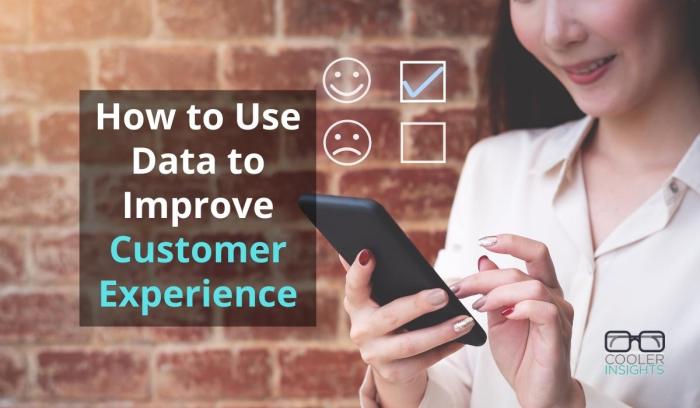Kicking off with Using Data to Improve Customer Experience, this opening paragraph is designed to captivate and engage the readers, setting the tone american high school hip style that unfolds with each word.
In today’s fast-paced digital world, understanding the importance of data in improving customer experience is key to staying ahead of the competition. From analyzing customer behavior to implementing personalized strategies, data-driven insights are revolutionizing the way businesses connect with their customers. Let’s dive into how leveraging data can take your customer satisfaction to new heights.
Importance of Data in Customer Experience Improvement
Understanding customer behavior is essential for businesses looking to enhance their customer experience. Data plays a crucial role in this process by providing valuable insights into customer preferences, trends, and interactions.
Data Sources for Enhancing Customer Experience
- Customer Feedback Surveys: Gathering feedback directly from customers through surveys helps in understanding their satisfaction levels and areas of improvement.
- Website Analytics: Analyzing website traffic, user behavior, and conversion rates provides valuable insights into customer interactions online.
- Social Media Monitoring: Tracking social media mentions, comments, and reviews allows businesses to gauge customer sentiment and address any issues promptly.
- Purchase History: Examining past purchase behavior helps in personalizing customer experiences and offering relevant recommendations.
Impact of Data-Driven Insights on Customer Satisfaction
Utilizing data-driven insights can lead to improved customer satisfaction by tailoring products and services to meet customer needs effectively. Businesses can anticipate customer preferences, address pain points, and deliver personalized experiences that resonate with their target audience.
Implementing Data-Driven Strategies: Using Data To Improve Customer Experience

In today’s digital age, leveraging data is crucial for enhancing customer experience. By implementing data-driven strategies, businesses can gain valuable insights that lead to more personalized and efficient customer interactions.
Collecting Relevant Data
To enhance customer experience, it is essential to collect relevant data from various touchpoints, such as customer interactions, feedback, purchase history, and website behavior. Utilizing tools like CRM systems, surveys, and analytics platforms can help gather this data effectively.
Analyzing Customer Data Effectively
Analyzing customer data requires a systematic approach to uncover meaningful patterns and trends. Best practices include segmenting customers based on demographics, behavior, and preferences, conducting A/B testing to optimize strategies, and utilizing data visualization tools for clear insights.
Translating Data Findings into Actionable Strategies
Once data is analyzed, it is crucial to translate findings into actionable strategies for improving customer experience. This involves identifying key pain points, creating personalized marketing campaigns, implementing targeted communication strategies, and continuously monitoring and adjusting based on customer feedback.
Personalization through Data Analysis

Personalized experiences play a crucial role in customer engagement by creating a unique and customized interaction for each individual. This tailored approach not only enhances customer satisfaction but also increases brand loyalty and drives repeat business.
Utilizing Data for Personalized Customer Interactions
- Segmentation: Data analysis allows businesses to segment their customer base according to demographics, behavior, preferences, and more. This segmentation enables targeted marketing campaigns and personalized recommendations.
- Recommendation Engines: By analyzing customer purchase history, browsing behavior, and interactions, businesses can develop recommendation engines to suggest relevant products or services to each customer.
- Personalized Communication: Data analysis helps in crafting personalized communication strategies through targeted emails, messages, and notifications based on individual customer preferences and behavior.
Benefits of Tailoring Customer Experiences, Using Data to Improve Customer Experience
- Increased Customer Satisfaction: Personalized experiences make customers feel valued and understood, leading to higher satisfaction levels and a positive brand perception.
- Improved Customer Retention: By offering personalized interactions, businesses can foster long-term relationships with customers, increasing their likelihood of returning for future purchases.
- Enhanced Customer Engagement: Tailoring experiences based on data-driven insights ensures that customers receive relevant and meaningful interactions, fostering deeper engagement with the brand.
Utilizing Feedback Data for Customer Experience Enhancement
Feedback data plays a crucial role in improving customer satisfaction by providing valuable insights into the customer’s experience with a product or service. By collecting and analyzing feedback data, companies can identify areas for improvement, address customer pain points, and enhance overall customer experience.
Role of Feedback Loops in Enhancing Customer Experience
Feedback loops are essential in continuously improving customer experience as they allow companies to gather feedback, make necessary adjustments, and measure the impact of those changes on customer satisfaction. This iterative process ensures that customer needs are met and expectations are exceeded over time.
- Implementing feedback mechanisms across various touchpoints to capture customer feedback in real-time.
- Analyzing feedback data to identify trends, patterns, and actionable insights for enhancing customer experience.
- Engaging with customers to understand their feedback better and demonstrate a commitment to addressing their concerns.
- Using feedback data to drive product/service improvements, streamline processes, and deliver personalized experiences.
Examples of Companies Leveraging Feedback Data
Amazon:
Amazon utilizes customer feedback data to enhance its product offerings, improve the shopping experience, and tailor recommendations based on customer preferences.
Netflix:
Netflix collects feedback from viewers to refine its content recommendations, enhance the user interface, and personalize the viewing experience for each user.
Zappos:
Zappos actively seeks feedback from customers to improve its customer service, website usability, and product selection, leading to higher customer satisfaction and loyalty.
Apple:
Apple incorporates feedback data into its product development process to create user-friendly products, address performance issues, and innovate based on customer needs and preferences.
